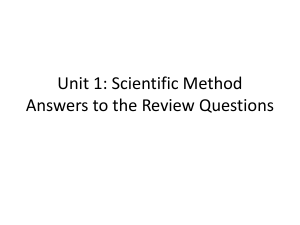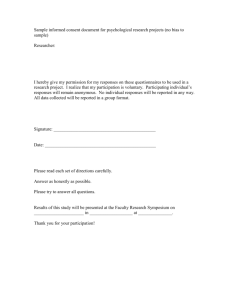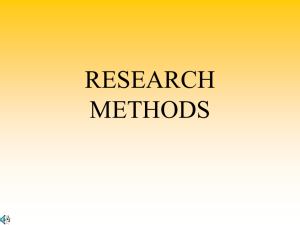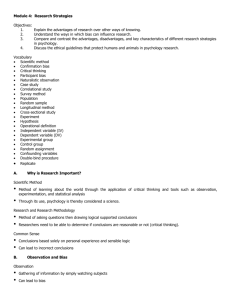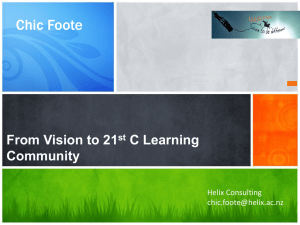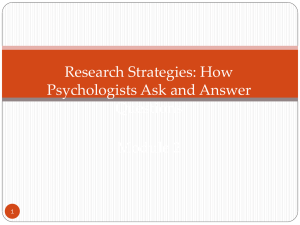THE SCIENCE OF PSYCHOLOGY
advertisement
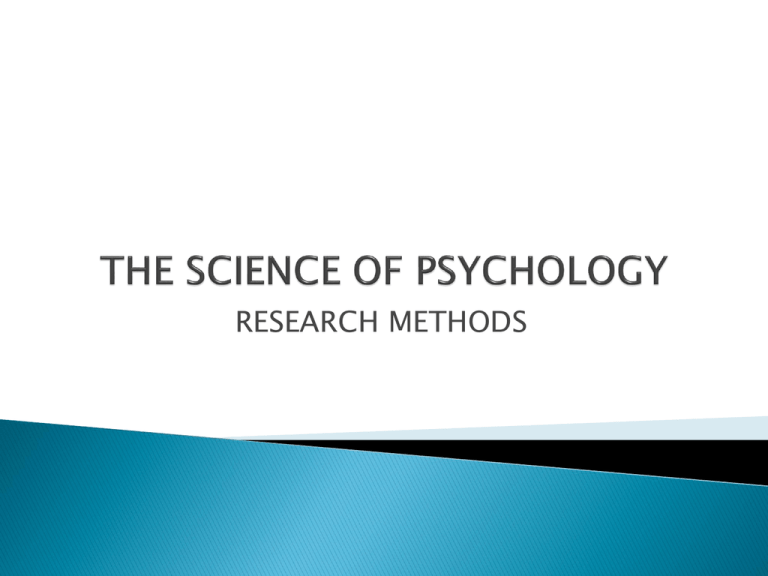
RESEARCH METHODS 1. PERCEIVING THE QUESTION What do you want to know about? 2. FORMING A HYPOTHESIS What is my educated guess? 3. TESTING THE HYPOTHESIS What method of research should I use? 4. DRAWING CONCLUSIONS How do I use statistics to draw conclusions? 5. REPORT YOUR RESULTS Share with others, allow for replication Do opposites attract? OR, Do birds of a feather flock together? http://www.freedigitalphotos.net/images/view_photog.php?photogid=4112">Image: metrue / FreeDigitalPhotos.net Simply wants to gather information Gives a detailed description Observes and records Does not seek to show relationships Best way to look at behavior of animals or people In natural environment Advantage: realistic picture of behavior because you are seeing it happen Disadvantages: -observer bias: see what expect to -observer effect: act differently because being watched http://www.freedigitalphotos.net/images/view_photog.php?photogid=1058">Image: Arvind Balaraman When observation in a natural setting is not practical NOT AN EXPERIMENT Advantages: gives more control to researcher Disadvantages: artificial setting means may not reflect behavior in “real world” http://www.freedigitalsphotos.net/i mages/view_photog.php?photogid= 1499">Image: Ambro / FreeDigitalPhotos.net One individual/small group are studied in great detail Uses all other methods of research Usually unusual/rare cases http://schoolswikipedia.org/images/5 26/52611.jpg Advantage: lots of detail/information Disadvantage: low generalizability-can’t really be applied to others Ask questions about topic you are studying Questionnaires, interviews, on internet Can ask about embarrassing/personal info Advantages: lots of information from large group of people, quick results, inexpensive Disadvantages: Social desirability bias: people want to look good Volunteer bias: people who participate are different Framing: way word questions can affect answers When choosing participants, can’t survey everyone from population Must choose people to be representative of whole group Random sample: everyone in the population has an equal chance to be in study More people, randomly chosen means more likely to be representative Generalizability: how well sample represents target population, do results apply to all? Seeks relationship between 2 variables Does NOT want to prove cause/effect Positive correlation: variables increase in the same direction more studying, better grades Negative correlation: variables have an inverse relationship more smoking, worse health Illusory correlation: no real relationship exists sugar and hyperactivity Statistics that show strength of the relationship between variables Perfect positive correlation = +1 Perfect negative correlation = -1 No correlation = 0 -1---------------0--------------+1 Further from 0 = stronger the relationship Graph to show correlations 10 8 6 Weight loss 4 2 0 0 5 10 IT IS THE ONLY METHOD THAT CAN SHOW A CAUSE AND EFFECT RELATIONSHIP BETWEEN 2 VARIABLES Researchers manipulate the variable they think is causing the change and then they CONTROL everything else but that variable, IF the other variable changes then they know it was due to their manipulation. CAUSE AND EFFECT Do violent cartoon shows cause children to be more aggressive? http://commons.wikimedia.org/wiki/File:Bugs_Bunny__Fresh_Hare_(_any_1942).JPG Independent variable: the variable being manipulated by the researcher Dependent variable: the variable that is being measured for change Operational Definitions: how the variables are going to be measured and quantified so that the research can be replicated IV: violent cartoons (what the researchers will control and manipulate) Operational definition: What makes a cartoon violent? How many acts of violence? Must quantify. DV: aggressive behavior (what they want to measure) Operational definition : What is an aggressive act? How will they know if a kid is more aggressive or less? Other factors that can affect the Independent Variable OTHER THAN the Dependent Variable Don’t allow for Cause-Effect conclusion Exs.: kid’s home-life, natural temperament, grumpy that day, hungry, tired, don’t like cartoons, mad they have to be in an experiment How to control for these?? Experimental group: get the experimental manipulation (watch the violent cartoon) Control group: don’t get the manipulation, there only for comparison (watch a nonviolent cartoon) MUST BE ALIKE IN EVERY OTHER WAY Random assignment: must have an equal chance of being in the control or experimental groups Placebos: fake treatments -placebo effect: expectations of participants can influence their behavior Single-blind: participant doesn’t know if in control or experimental group -subject bias: tendency to act how they think they are supposed to act Double-blind: neither participant nor researcher knows the group -experimenter bias: researcher unintentionally influences the study Participants in research have the right to expect that no physical or psychological harm will come to them. Guidelines are established by the American Psychological Association Institutional Review Boards: check over the proposed research for ethical concerns and for any flaws in the design Why use animals? Shorter lives = long-term effects sooner Easier to control Simpler behavior=easier to see manipulations Can do things to animals can’t do to humans Least amount of harm possible 1. 2. 3. 4. 5. 6. 7. informed consent deception must be limited and justified participants can withdraw at any time confidentiality must be maintained no long-term mental risk no physical risk debriefing
